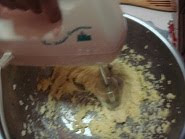This recipe is excellent for children above 9 years old. My 5 year old joined in. He was given tasks that he could handle and everyone had quite a bit of fun!
Shopping Cart for the Cup Cake Recipe
Makes about 6 to 7 cupcakes
For the cup cake
100 grams of caster sugar (you can reduce it a little if you don’t like your cakes too sweet)
100 grams of very soft butter (use good quality butter – it helps with the softness and moisture)
100 grams self raising flour
2 eggs
For the icing
200 grams soft butter
200 grams icing sugar (you can reduce it a bit if you don’t like too sweet icing)
Colourings, sprinkles, nuts and whatever your kids fancy
Firstly, to help your kids with reading the recipes, print or write it on a piece of paper in big letters:
1 Ask a grown up to turn on the oven to 180°C.
2 Get a big bowl – stainless steel is best
Weigh the butter and mix it into the bowl.
Kids, you can mix and beat the mixture. It is a great to enhance your motor skills.

Secret Number 1 is to use a beater. It will let the mixture be even and soft. The longer the better.
Get a grown up to help you.
Sift in the flour. Weigh it carefully
Secret 2: I added some baking soda (half a teaspoon)
3 Break the eggs into a separate bowl. Don’t forget to spoon out bits of shells.
Add to the batter.
Add the vanilla essence
4 Use a spoon and place it in paper cases.
 |
| Add batter to into the paper case and the cake bowls |
Ask a grown up to place in the oven for 20 minutes
 |
| Making the icing. |
5 While the cupcakes are baking, make some creamy icing
Mix the butter and cream it with the icing sugar.
Add colouring as you like. My boys love orange.
Use an icing bag or simply role some of the icing onto some paper shaped like a ice cream cone.
6 Let the cakes cool properly .
Pipe the icing onto each cake and decorate as your like.
Parents,
Your kids learn tones from this simple recipe. Prepare the shopping list. As you can see this cup cake recipe does not cost much and easy to do. Splendid for dessert and for guests.
Your kids are reading, weighing, estimating, and bonding.
Does wonders to the self esteem and confidence .
This entry has links to where you can get some of the things such as ovens and other baking stuff.
Happy Cooking and Teaching































